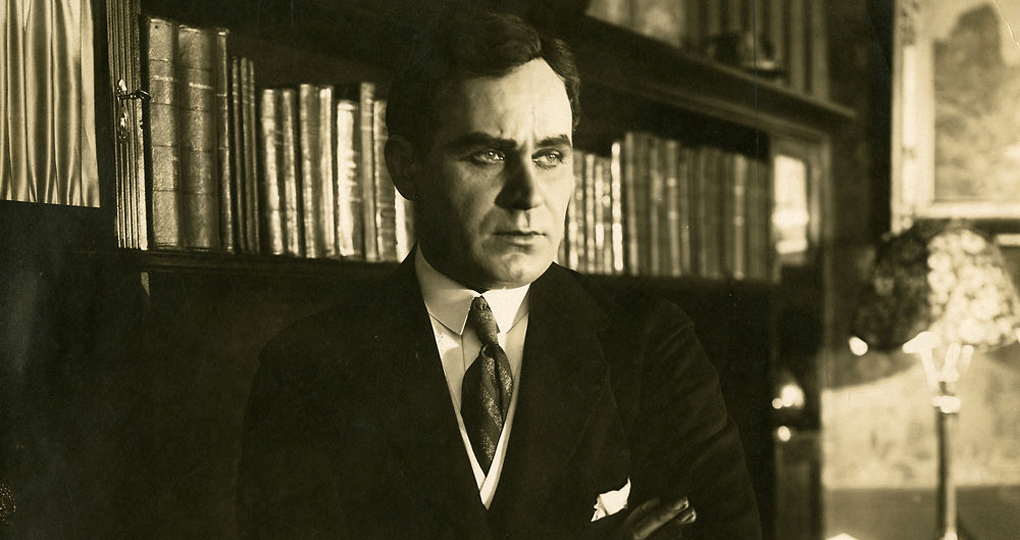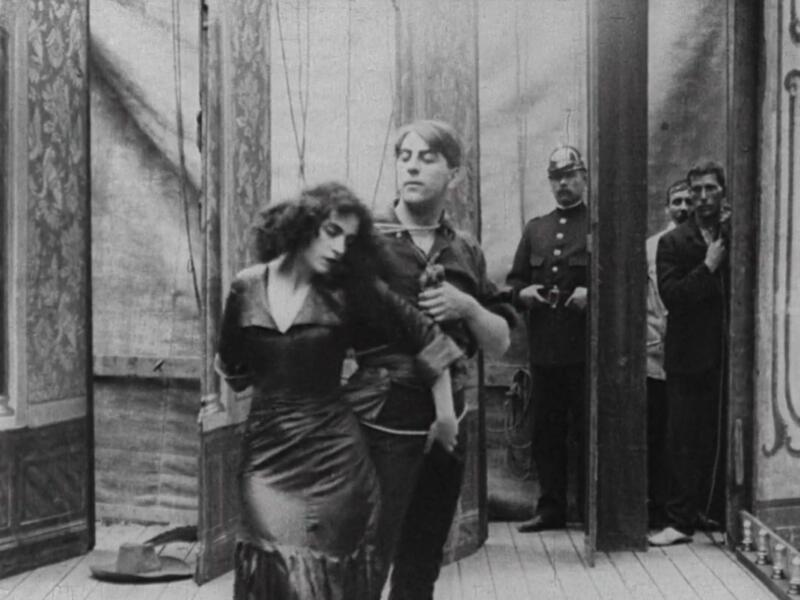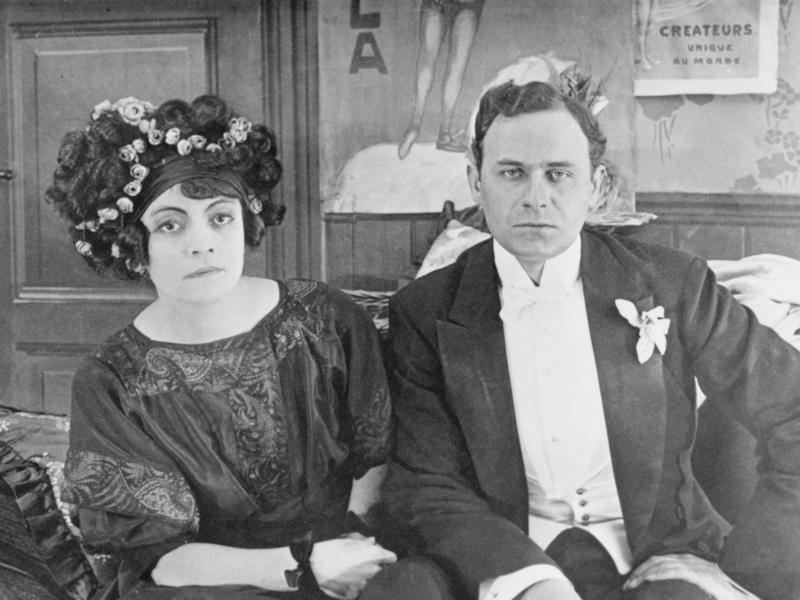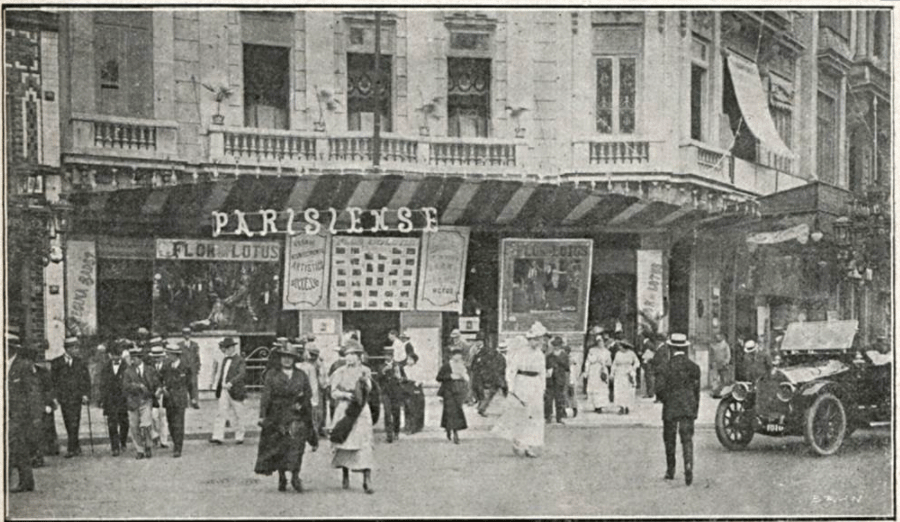
On October 19, 1915, the Rio de Janeiro newspaper Correio da Manhã announced a contest to determine “Among male dramatic artists, which is the preferred of the female reader?” Following on the heels of a similar contest dedicated to female screen performers, this initiative signals the growing importance of stars within a local exhibition market dominated by French, Italian, Danish, and increasingly, American films. The final results of the contest—in which the Dane Valdemar Psilander triumphed by a comfortable margin over his closest rivals, the Italian Emilio Ghione and the American Arthur Johnson—speaks to how the personas of early global film stars resonated with audiences, exhibitors, and distributors in Brazil. Letters poured in praising Psilander’s dramatic talent, physical appeal, embodiment of erotic passion, and above all, refinement and sophistication. Even as the risqué themes of Danish erotic melodramas tested the limits of prevailing social norms, fan letters and advertisements championing Psilander as “the arbiter of elegance” indicate the significance of cinema’s upper-class associations in a city where the medium had been quickly embraced by local elites beginning with the establishment of permanent movie theaters in 1907.1
Psilander’s popularity in Rio de Janeiro in the mid-1910s was shaped by the scarcity of European film imports during the First World War, which seems to have contributed to the re-exhibition of several features starring him that had been shown earlier in the decade, most notably Ved Fængslets Port/Tentação nas grandes cidades/Temptations of a Great City and Balletdanserinden/Amor de dançarina/The Ballet Dancer, both directed by August Blom for the Nordisk Films Kompagni in 1911.2 At the same time, reprises of Psilander’s films are indicative of the ongoing competition between the Companhia Cinematográfica Brasileira (CCB), a powerful distribution-exhibition conglomerate owned by Spanish impresario Francisco Serrador, and companies that resisted its attempts to dominate film distribution and exhibition in the southeastern cities of Rio de Janeiro and São Paulo. After distributor-exhibitor Giacomo Rosário Staffa, owner of Rio de Janeiro’s centrally located Cinema Parisiense, broke away from the CCB, his exclusive contract to distribute Nordisk films (as well as the series of Deutsche Bioscop films starring Danish star Asta Nielsen) continued to offer a competitive edge against the conglomerate.3 Advertisements for the Cinema Parisiense highlighted the Nordisk brand, as well as actors like Psilander and Nielsen (in an illustration of Richard deCordova’s notion of the emerging “picture personality” of the 1910s as “a viable means of product differentiation”), in order to distinguish Staffa’s programs from those of CCB-affiliated venues (deCordova 2001: 50). Furthermore, references in advertisements to Psilander’s sophisticated star image helped bolster the Parisiense’s somewhat tenuous claims to a refined, upper-class clientele.
Moviegoing in civilized Rio
Such claims were key for maintaining prestige and winning patronage among affluent spectators in a capital whose watchword was “Rio is becoming civilized” (“O Rio civiliza-se).4 Rio de Janeiro possessed the nation’s most robust exhibition market in the period, making it a compelling case study of emerging forms of film culture and stardom in Brazil. By the end of the first decade of the twentieth-century, moviegoing had been incorporated into elite rituals of public circulation in a cityscape reshaped by recent urban reforms. As part of turn-of-the-century urban renewal projects spearheaded by city prefect Francisco Pereira Passos, modeled on Georges-Eugène Haussmann’s transformation of Paris, working-class housing and colonial-era buildings were razed to allow the construction of broad boulevards. Designed to help Rio de Janeiro shed its image as an unhygienic, unsavory port city and present itself as a cosmopolitan capital, these developments fostered new forms of consumer and leisure culture, as wealthy cariocas (Rio de Janeiro residents) increasingly frequented downtown commercial districts.5 Society columnists defined fashionable times to attend the cinema (“soirées da moda”), while illustrated magazines frequently published images of white, elegantly dressed moviegoers.6 At the same time, class- and race-based distinctions between movie theaters emerged quickly. In 1907, Staffa’s newly opened Cinema Parisiense was deemed a “point of rendezvous for mulatas and crioulas”—that is, female moviegoers of African descent, which was closely correlated with working-class status in Brazil’s racially stratified society. Brazil became the last nation in the Western hemisphere to abolish slavery in 1888, and while the rigid colorline enforced in the United States did not function in the same way in Brazil, social mobility remained limited for formerly enslaved people and their descendants. As we shall see, the cultural capital attached to European—particularly Danish—film imports played a key role of Staffa’s increasing pursuit of an elite clientele after 1911, despite the venue’s small size (approximately 160 seats) and location on the less desirable side of the Avenida Central in the city center.8

The “furious sensual” kisses of Nordisk
Attending to Psilander’s stardom in Rio de Janeiro helps focus attention on two often neglected dimensions of global film culture in the 1910s: the historical significance of Latin American exhibition markets for major film-producing nations, and the formative presence of imported cinema in the region, beyond the opposition between
Hollywood and domestic production that structures many scholars’ accounts. In 1914, Brazil figured among the top four importers of Italian films, behind Britain, France, and Austria-Hungary; by 1922, it was one of the top five markets for Hollywood studios, along with Argentina (Thompson 1985: 87, 137). Conversely, histories of Latin American cinema tend to gloss over the pre-1916 period when European cinema dominated screens in the region.9 One notable exception is the work of José Inácio de Melo Souza, who demonstrates the pivotal role of imported—especially French—cinema in the development of exhibition in Rio de Janeiro. Melo Souza complicates previous narratives of the era prior to the 1911 emergence of the CCB (which developed an integrated distribution-exhibition circuit supplied mainly by imported films), often described as a “bela época” or “golden age” of Brazilian cinema. He observes that even the sweeping success of homegrown genres such as the filmes falados e cantantes (“talking and singing films” accompanied by live dialogue and musical performances) ultimately played a “marginal” role in the business of film exhibition, although they helped sustain exhibitors who engaged in production (Melo Souza 2003: 16).
Signaling Danish cinema’s privileged place within a Rio de Janeiro exhibition market reliant on European product, Psilander’s star status was shaped by the broader local reception of the Danish erotic melodrama. Ironically, the genre’s salacious appeal was linked to the cold Nordic climate, framed as exotic by the local press. In the wake of the exhibition of Ved Fængslets Port and Afgrunden (A queda da mulher/The Abyss, Urban Gad, Kosmorama, 1911), starring Asta Nielsen, the illustrated magazine Careta declared that the questionable morality of Nordisk films surpassed that of Pathé’s productions: “Naturally, because in the cold, melancholy regions of Denmark morality has less interest than in Paris.”10 (It should be noted that the local press often used “Nordisk” as a synonym for Danish cinema more broadly, in this case with only partial accuracy.) The commentator describes “the effect produced on the timid and repentant” by these morally—and erotically—charged films, adding that the “common people truly enjoy such things.”11 The journalist’s tone suggests the connotations of vulgarity attached to French and Danish melodramas, an association implicitly contested by references to Psilander’s refined and urbane star persona in publicity discourses. Similarly, the illustrated magazine Fon-Fon discussed Nordisk films in terms of stereotyped notions linking nationality and sensuality,, declaring: “What the police do not permit, is the Nordisk kiss, this furious sensual kiss, banal in the passionate reveries of the cold people of the northern countries . . . .The police want the sentimental Latin kiss, romantic and brief. They will even consent to the English or German kiss, cold and tame. What they do not want is the Scandinavian kiss.”12 As these texts suggest, the Nordisk brand was closely linked with broader debates surrounding public displays of sexuality in 1910s Rio de Janeiro. These debates encompassed both discussion of film exhibition and journalistic texts that described couples exchanging furtive embraces “in the style of Nordisk.”13
Unbridled eroticism and "Nordisk kisses" in Ved Fængslets Port/Tentação nas grandes cidades/Temptations of a Great City.
As associations between Danish films and unbridled sensuality emerged in the local press between 1911 and 1913, publicity discourses slowly began to highlight Psilander’s screen appearances as a selling point, while frequent reprises of his films suggest his lasting popularity. Advertisements for Ved Fængslets Port and other early films starring Psilander either omit his name or misidentify him as “Biegelow” or “Bircelow,” possibly an error derived from translated intertitles.14 Between 1912 and 1914, he is identified as “Wuppschlander” in publicity for at least eighteen titles released in Rio de Janeiro, including Mormonens Offer/Vítima do Mormon/A Victim of the Mormons (August Blom, Nordisk, 1911) and Den sorte Drøm/Sonho negro/The Black Dream (Urban Gad, Fotorama, 1911), co-starring Asta Nielsen.15 Advertisements often reminded moviegoers of his role in Ved Fængslets Port, which was reprised multiple times in Rio de Janeiro between 1911 and 1918.16 At least five films starring Psilander from 1911 and 1912 were re-released during 1915—including Ved Fængslets Port, Mormonens Offer, and Balletdanserinden—along with eight new titles featuring the actor.17Throughout this period, advertisements for the Cinema Parisiense stressed Staffa’s exclusive rights to Nordisk films, and evidence from the aforementioned star popularity contest does suggest that the star’s screen performances were a draw for local moviegoers.18 After Psilander’s untimely death in 1917 until as late as 1922, Staffa re-released films starring the actor from the early teens, obtained during a trip to Europe to purchase Italian, French, German, and Scandinavian films to re-launch his exhibition business after a hiatus.19
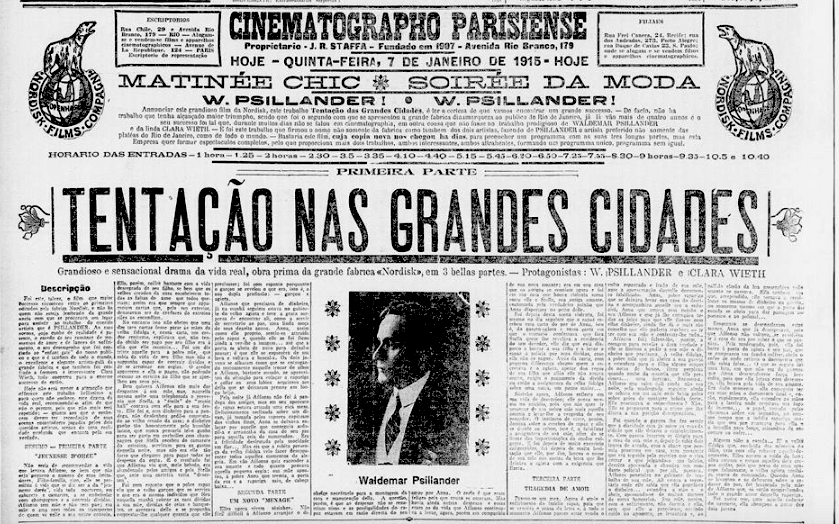
Wuppschlander
Although film criticism as such did not exist in the Rio de Janeiro press of the 1910s, advertisements frequently incorporated lengthy summaries of film plots, reminiscent both of the souvenir programs distributed at screenings in Denmark (which tended to narratively justify and contain the transgressive themes of the film
texts) and the folhetim (serial novel), a staple of nineteenth and early twentieth-century Brazilian newspapers (Sandberg 2001: 6-22). These extensive descriptions, illustrated with publicity stills, are often bracketed by claims of a particular film’s artistic value (often reinforced by references to the global success of the Nordisk brand) and the skill of its performers. A suggestive example appears in a 1912 advertisement for Os dois forçados (The Two Slaves): “Wuppschlander, the famous actor from the Royal Danish Theatre . . . is of impeccable artistry in this painful and gripping sally! That anguished soul, as if trembling under the weight of a thousand winters, expands completely . . . with a simple gesticulation!” Not surprisingly, the text evokes Psilander’s training in legitimate theatre and “the artistry that has made him popular with European audiences” as measures of quality.20
While an imperfect measure of public perceptions, the aforementioned 1915 star popularity contest sponsored by the Correio da Manhã gives some sense of Psilander’s public appeal and his position within the panorama of the local film market. The newspaper published a large number of film-related advertisements, which were presumably a valued source of revenue; thus, it likely had economic incentives for offering publicity and opportunities for cross-promotion to local exhibitors. After Francesca Bertini triumphed narrowly over Asta Nielsen in the earlier contest dedicated to female stars, the Odeon (part of the CCB’s exhibition circuit) organized a special gala screening for female fans, with free tickets distributed from the offices of the newspaper.21 During the second contest, the Cinema Parisiense apparently took advantage of the publicity by screening Kærlighedens Triumf(Domesticando um coração/The Romance of a Will, Holger-Madsen, Nordisk, 1915), going so far as to incorporate into its advertisements a letter written by one of Psilander’s fans, which had previously been printed in the Correio da Manhã.22 Like several of the missives published by the newspaper during the contest, this letter was written in French, and was penned by a female fan who was likely well-educated and affluent. In the Cinema Parisiense’s publicity, the letter was marshaled as proof that the venue’s offerings were attracting a refined clientele, in turn helping the venue draw in well-heeled spectators.
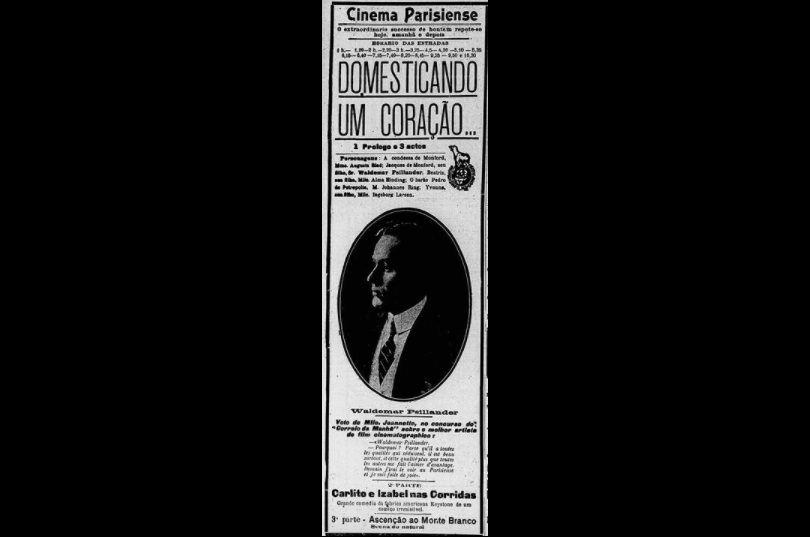
Building on elements of the Cinema Parisiense’s publicity for films starring Psilander and for Nordisk productions in general, as well as audiences’ knowledge of Psilander’s onscreen roles, reader letters published in the Correio da Manhã stressed the actor’s physical attractiveness, naturalistic use of gesture, and sophistication in dress and manner.23 Notably, these fan letters do not manifest the keen interest in revelations about the star’s private life in the manner that deCordova observes emerging in the United States around 1913 and that Richard Dyer has argued are central to the personas of later stars.24 Nevertheless, fans praised the emotional intensity of his performances and his power to “fascinate, seduce, enchant, and ravish!,” in the words of one reader, who continued, “In short, he breaks hearts, and leaves the soul in torment.”25 One representative statement from a reader signals how erotic appeal and artistic skill were linked in Psilander’s star image: “His impassioned soul is expressed in his lovely green eyes. His artist’s soul is expressed in his gestures, spontaneous and rich in naturalness. His nobility and physical beauty is expressed in his distinguished features. The combination demands the vote.”26 Other readers, however, suggested that Psilander’s emotive powers paled beside those of Emilio Ghione, who “excites the audience in violent scenes of ‘apaches,’ his favorite creation” in films like Za-la-Mort (Emilio Ghione, Tiber-Film, Italy, 1915).27
“Supplanted by misty Denmark”
The rivals that Psilander faced during the Correio da Manhã’s October 1915 contest—the French actor Gabriel Signoret and the Italians Ghione, Gustavo Serena, Alberto Capozzi, and Mario Bonnard—signal the dominance of Italian and French cinema on Brazilian screens, just prior to the aggressive expansion of U.S. production companies into foreign markets during the First World War. In May 1915, Universal became the first North American studio to open a local branch in Brazil; Fox and Paramount quickly followed (Melo Souza 2003:328; Thompson 1985:72). Arthur Johnson was the only American actor to receive a substantial share of votes in the contest (8,262 to Ghione’s 8,513 and Psilander’s 10,382).28 Although Johnson was rarely mentioned by name in local advertisements (the majority of his screen appearances predate the emergence of “picture personalities” around 1909) fans recalled his roles for Biograph and Lubin with nostalgia.29 One defender of Arthur Johnson noted the scarcity of North American films in local movie theaters and exhorted fellow readers: “Do not allow free, strong America to be supplanted by misty Denmark!”.30 Ironically, Psilander’s victory in the Correio da Manhã contest heralded the twilight of Danish—and indeed, European—stars in Brazilian film markets, soon to be dominated by Hollywood films.
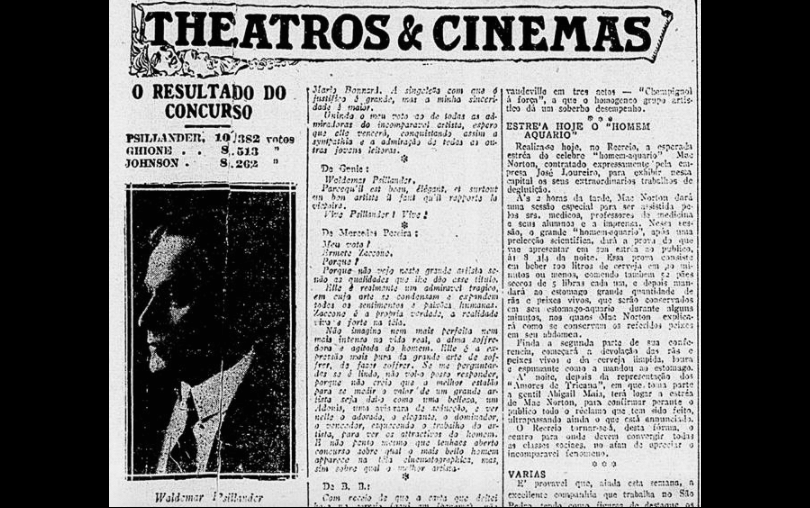
The announcement of Psilander's victory in the star popularity contest, in which he triumphed over Emilio Ghione and Arthur Johnson by a margin of over 2,000 votes. Correio da Manhã, 1 November 1915.
Arising at the confluence of fierce competition between local impresarios and film shortages linked to the First World War, Psilander’s stardom in Brazil built on the risqué reputation of Nordisk’s erotic melodramas and tapped into persistent links between moviegoing and elite diversions in a self-consciously cosmopolitan and modernizing capital. Stressing the international renown of Nordisk and its prominent performer, the Cinema Parisiense’s publicity leveraged the figure of Psilander to differentiate its offerings and—perhaps more importantly its audiences—within the local exhibition market. The resonances of Psilander’s star persona in Rio de Janeiro thus signal the local uses of emerging stars in the distinctly global film culture of the 1910s.
BY: RIELLE NAVITSKI / ASSISTANT PROFESSOR AT UNIVERSITY OF GEORGIA
Notes
The phrase “arbiter of elegance” is taken from a fan letter printed in the newspaper. Maud [pseud], “Um novo concurso,” Correio da Manhã, 20 October 1915, 5. The phrase also appears in an advertisement for the Cinema Parisiense, Correio da Manhã, 18 March 1915, 12. While anachronistic, the term “erotic melodrama” is widely used in scholarship on Danish silent film. See Engberg (1993: 63-67). On the early formation of an elite film audience in Rio de Janeiro, see Melo Souza (2003: 119, 129-133).
Advertisement, Correio da Manhã, 7 January 1915, 12; advertisement, Correio da Manhã, 14 January 1915, 12. Melo Souza (2003: 313) mentions frequent reprises of films from 1910 and 1911 in São Paulo in 1915.
Melo Souza (2003: 304-10). Staffa acquired the exclusive rights to Nordisk films in 1910, according to Gonzaga (1996: 92). On Asta Nielsen’s stardom in Brazil, see Navitski (2013: 291-99).
Brazil’s current capital, Brasília, was inaugurated in 1960.
On urban reforms, see Needell (1987: 31-45). On urban space, consumer culture, and cinema, see Conde (2011: 5-6, 27-32).
Melo Souza (2003: 119, 143-45, 152).
“Bastidores,” O Rio Nú, 4 September 1907, 6.
At this time, Staffa began remodeling the venue; he later eliminated his second-tier admission prices. Gonzaga (1996: 86, 92, 277).
For example, Serna (2015) focuses on the presence of American films post-1917. For a detailed account of the Mexico City exhibition market in the 1910s, including a breakdown of films by nationality, see Amador and Blanco (2009), See also Miquel (2013).
Afgrunden was first shown in Rio de Janeiro in early August. “Tópicos e notícias,” Correio da Manhã, 11 August 1911, 1. Ved Fængslets Port, first shown in May, was reprised shortly thereafter, perhaps to capitalize on Afrgrunden’s success. “O que vae pelos cinemas e outras casas de diversões,” Correio da Manhã, 26 May 1911, 3; “O que vae pelos cinemas e outras casas de diversões,” Correio da Manhã, 13 August 1911, 5.
Conde de Luxo em Burgo [pseud.], “Cinemas e fitas,” Careta, August 19, 1911.
Fon-Fon, 28 June 1913, 54.
Trepador [pseud.], “Trepações,” Fon-Fon, 3 August 1912, 29. See also A’R. C. [pseud.], “As Amoras,” Fon-Fon, 21 June 1913, 65.
Advertisement for Ved Fængslets Port, 4 June 1911, 14; advertisement for Balletdanserinden, Correio da Manhã, 23 December 1911, 12; advertisement for Balletdanserinden, Correio da Manhã, 25 December 1911, 12.
Advertisement for Vítima do Mormon, Correio da Manhã, 2 February 1912, 10; advertisement for O sonho negro, Correio da Manhã, 26 May 1912, 15. In many cases, a lack of detail in advertisements and non-specific titles such as As nossas mulheres modernas (Our Modern Women) and Sob o domínio da paixão (In the Thrall of Passion) make it difficult to identify original titles and unique releases, as opposed to films that may have been re-released under another title.
Advertisement for En Lektion/O aviador ou a mulher do jornalista/The Aviator and the Journalist’s Wife (August Blom, Nordisk, 1911), Correio da Manhã, 17 September 1911, 16; advertisement for Linda mademoiselle (possibly Hendes Ære/Lady Mary’s Love, August Blom, Nordisk, 1911), 24 October 1911, 12. Advertisement, Correio da Manhã, 2 September 1918, 12.
Advertisement, Correio da Manhã, 11 February 1915, 12.
Letter from R. Camera [pseud.], “Um novo concurso,” Correio da Manhã, 21 October 1915, 5. See also letter from Miss Flower [pseud.], “Um novo concurso,” Correio da Manhã, 20 October 1915, 5.
“Os films da semana,” Para Todos..., 31 December 1921, 31; “Os films da semana,” Para Todos..., 14 January 1922, 31; Operador [pseud.], “Crônica,” Para Todos... 18 December 1920, 16. Staffa administered the Cinema Parisiense, at some points in partnership with other businessmen, from 1907 to 1917 (Gonzaga 1996: 276).
I have been unable to identify this film from the information available. Advertisement, Correio da Manhã, March 19, 1912, 12.
A letter from CCB owner Francisco Serrador published in the same news item linked Bertini closely to his venue, describing her as “the favorite daughter of the Odeon.” “Ainda o nosso concurso,” Correio da Manhã, 19 October 1915, 4.
Advertisement, Correio da Manhã, 22 October 1915, 12. The letter, signed “Jeannette,” was previously printed in “Um novo concurso,” Correio da Manhã, 21 October 1915, 5
Here, I am drawing on Richard Dyer’s conception of stars as a form of signification across media texts in Stars (1981). DeCordova also stresses that the “picture personality” of the early 1910s relied less on references to a theatrical persona, and more on intertextual knowledge of other screen performances in Picture Personalities, 50-52.
DeCordova (2001: 98-100); Dyer (1987: 22-23, 109-11). Consultation of the press indicates that little discursive material of this type relating to Psilander circulated in 1910s Rio de Janeiro.
Letter from Grace Weiss, “Um novo concurso,” Correio da Manhã, 23 October 1915, 5.
from Liliana [pseud.], “Um novo concurso,” Correio da Manhã, 20 October 1915, 5.
Letter from Mocinha [pseud.], “Um novo concurso,” Correio da Manhã, 21 October 1915, 5.
“O resultado do concurso,” Correio da Manhã, 1 November 1915, 5.
Letter from Zazá [pseud.], “Um novo concurso,” Correio da Manhã, 20 October 1915, 5; letter from Gladys [pseud.], “Um novo concurso,” Correio da Manhã, 21 October 1915, 5.
Letter from Gladys [pseud.], “Um novo concurso,” Correio da Manhã, 21 October 1915, 5.
Literature
Amador, María Luisa and Blanco, Jorge Ayala (2009) Cartelera cinematográfica 1912-1919, Mexico City: Universidad Nacional Autónoma de México.
Conde, Maite (2011) Consuming Visions: Cinema, Writing, and Modernity in Rio de Janeiro, Charlottesville: University of Virginia Press.
deCordova, Richard (2001) Picture Personalities: The Emergence of the Star System in America, Champaign: University of Illinois Press.
Dyer, Richard (1981) Stars, London: BFI.
Engberg, Marguerite (1993) “The Erotic Melodrama in Danish Silent Films, 1910-1918.” Film History5, no. 1 (1993): 63-67.
Gonzaga, Alice (1996) Palácios e poeiras: 100 anos de cinemas no Rio de Janeiro (Rio de Janeiro: Fundação Nacional de Artes, 1996).
Melo Souza, José Inácio de (2003), Imagens do passado: São Paulo e Rio de Janeiro nos primórdios do cinema, São Paulo: Senac.
Miquel, Ángel (2013) En tiempos de revolución. El cine en la Ciudad de México, 1910-1916, Mexico City: Filmoteca de la UNAM.
Navitski, Rielle (2013) “Asta Nielsen as Import Commodity: International Film Stardom and Local Film Distribution in Brazil, 1911-1915". In Loiperdinger, Martin and Jung, Uli (eds.): Importing Asta Nielsen: the International Film Star in the Making, 1911-1914, New Barnet: John Libbey Publishing.
Needell, Jeffrey (1987) A Tropical Belle Époque: Elite Culture and Society in Turn-of-the-Century Rio de Janeiro, Cambridge: Cambridge University Press.
Sandberg, Mark (2001) “Pocket Movies: Souvenir Cinema Programmes and the Danish Silent Cinema.” In: Film History 13, no. 1, 6-22.
Serna, Laura Isabel (2015) Making Cinelandia: American Films and Mexican Film Culture Before the Golden Age, Durham, NC: Duke University Press.
Thompson, Kristin (1985) Exporting Entertainment: America in the World Film Market, 1907-34, London: British Film Institute.
Suggested citation
Navitski, Rielle (2017): "The Arbiter of Elegance": Psilander’s Stardom and Elite-Oriented Film Culture in Rio de Janeiro. Kosmorama #267 (www.kosmorama.org).
Watch the films at Stumfilm.dk:
